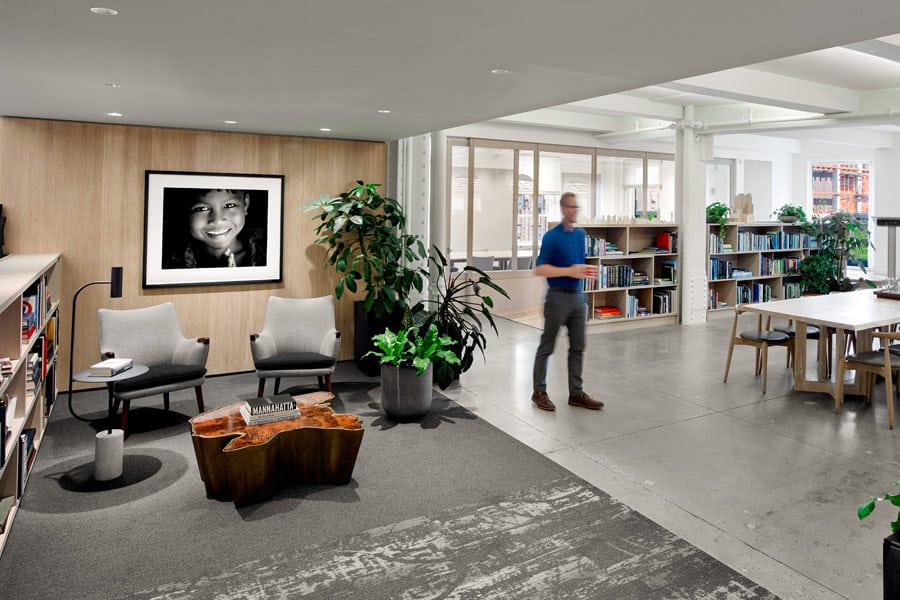The Amazon Spheres in Seattle. One Bryant Park in New York City. One Central Park in Sydney, Australia. These and other recent structures connect humans with nature through a design concept pioneered by Yale Professor Stephen Kellert and covered in his groundbreaking 2008 book, “Biophilic Design.” Biophilia means love of nature, and Kellert offered a framework for using nature in the built environment to meet human needs.
The COVID-19 pandemic has accelerated interest in designing and constructing buildings that enhance occupants’ physical and mental well-being while improving productivity and sustaining the environment. For example, corporations are expressing a desire to add outdoor spaces and encourage greater mobility inside healthy buildings.

Other biophilic elements might include use of plant walls to clean the air, natural materials like wood and stone for stress relief, waterfalls and rivulets for focus or relaxation and lights that vary in color temperature to reflect circadian rhythms.
To learn more about biophilic design, Built, the Bluebeam Blog, recently interviewed Mark Rusitzky, a partner at COOKFOX Architects in New York City.
Built Blog: How would you define biophilic design?
Rusitzky: Biophilic design is a design strategy that supports our innate human connections to nature to support our health and well-being. My definition of biophilia is this: people feel better when they feel connected to nature.
Built Blog: Do you agree with the criticism that environmentally sustainable design focuses too much on quantitative aspects of structures rather than qualitative aspects that impact humans—that it considers the planet more than the people?
Rusitzky: No. What we have learned is that when we design buildings that are better for the planet, we can quantitatively improve the lives of people.

Built Blog: Do you consider biophilic design a way to address the qualitative aspects?
Rusitzky: It is not just qualitative but evidence-based, outcome-based design. You can’t help but achieve a qualitative result when you use biophilic design because it isn’t a checklist of features—it’s a holistic design strategy. For example, material choices that are natural or natural analogues change your qualitative experience.
Built Blog: Tell me about the COOKFOX Studio’s use of biophilic design. What guiding principles influenced your choices?

Rusitzky: Our goal was to design the most sustainable and the healthiest space possible. We used high-performance systems and biophilic design, and measured our outcomes using the LEED and WELL certifications. We were guided by “14 Patterns of Biophilic Design,” a book we co-wrote with Terrapin Bright Green.
Built Blog: How does biophilic design complement environmentally sustainable design?
Rusitzky: Design strategies that address human health and well-being—such as daylighting, better indoor air quality and natural materials and views—relate to strategies and sustainable design goals to achieve energy savings and reduce impact on the planet.
Built Blog: Has COVID-19 impacted desire for biophilic design? Has it changed how you approach building design?
Rusitzky: COVID-19 has inspired a greater interest in health and wellness strategies, including biophilic design, but we were seeing these trends before COVID-19. In certain ways, COVID-19 has created greater attention on how to move people through lobbies, reduce load on elevators and make stairs more attractive alternatives. The bigger impact will come with time as we adapt to more permanent solutions that meet the new demand for flexible, resilient workplaces.

Built Blog: In what ways has COVID-19 influenced how you manage remote or fluctuating numbers of workers in commercial buildings or ensure social distancing in retail environments?
Rusitzky: Over the past few months, we’ve done many studies to design better traffic flows through buildings and create touchless entries. But these are short-term responses. In the long term, we believe we’ll be focused on creating more flexible buildings, with more entrances, communicating stairs and other ways of reducing pinch points, as well as outdoor space.
Built Blog: How does biophilic design impact the construction of a building? What does it change?
Rusitzky: We use biophilic design to support our health and wellness outcomes. Our holistic approach causes us to consider all aspects of the building. Material choices that are sustainably sourced and produced without harmful chemicals in the supply chain are critical to constructing a healthy building.

Many of our projects are focused on authenticity and the way that people react to things that feel authentic. For example, at 550 Washington, currently under construction on the West Side of Manhattan, we are repurposing a railroad terminal building in order to preserve a sense of authenticity. This element feels authentic, not because it is old, but because it tells the story of that place, what it was used for, the history of its use.
Built Blog: How does biophilic design impact the maintenance, sustainability and energy efficiency of a building?
Rusitzky: Biophilic design does not impact maintenance; however, biophilic design strategies often improve sustainability and impact the energy efficiency of buildings. Although higher air filtration may increase energy use by a small percentage, daylighting strategies may reduce energy use. Green roofs and planted terraces may extend the life of the roof.
Built Blog: How do you design for changing seasons, when the weather isn’t conducive for building occupants to use outdoor green spaces?

Rusitzky: Speaking from our own experience of our terraces, even in bad weather, just having views to nature has cognitive benefits. We have found that many people use our terraces in all seasons. Even a few minutes outdoors in a garden, no matter the season, can boost our productivity and sense of well-being. We advocate for accessible outdoor space and we bring nature inside, with plants, natural analogues, natural materials. Biophilic design is not as simple as creating a terrace, living wall or some other singular feature.
Built Blog: Do you believe biophilic design has a moral or ethical element?
Rusitzky: Absolutely. The moral and ethical mandate to create healthy buildings is the reason why our office has been focused on biophilic design for many years. If we know how to help children learn better, if we know how to improve health and wellness, if we know how to reduce stress, we must do it. For us, these things become a marker of good design as well as a moral responsibility.












